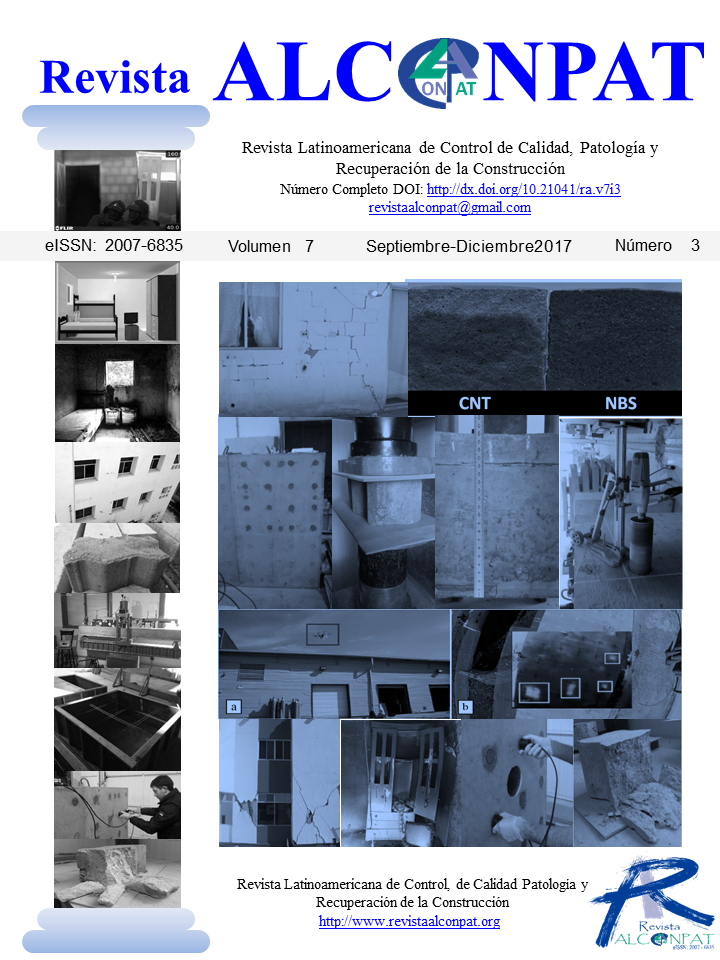Compressive strength in concrete paving blocks. Results leading to validate the test in half-unit specimens
Abstract
With the purpose of validating the compressive strength test result on half-unit specimen for concrete paving blocks quality control, experimental results on half-unit and whole unit blocks from 24 production batches were analyzed. The compressive strength results in whole unit was greater than in half-unit specimen, but they are connected by a form factor. Although the study was limited to a range of resistance in a single block shape and thickness, it could be established that it is possible to test half-unit units for quality control. This allows the other specimen half to be used for another test, simplifying the work controls in a smaller quantity of paving blocks needed and the possibility of using presses of lower capacity.
Downloads
References
ASTM C140/C140M (2017), “Standard Test Methods for Sampling and Testing Concrete Masonry Units and Related Units”, ASTM International, (West Conshohocken), PA, 2017, p. 25, DOI: 10.1520/C0140_C0140M-17, www.astm.org.
ASTM C42/C42M (2012), “Standard Test Method for Obtaining and Testing Drilled Cores and Sawed Beams of Concrete” ASTM International, (West Conshohocken), PA, 2012, p. 8, DOI: 10.1520/C0042_C0042M-12, www.astm.org.
ASTM C936/C936M (2016), “Standard Specification for Solid Concrete Interlocking Paving Units”, ASTM International, (West Conshohocken), PA, 2016, p. 4, DOI: 10.1520/C0936_C0936M-16, www.astm.org.
Barbosa, C., Hanai, J., Lourenço, P.,“Numerical validation of compressive strength prediction for hollow concrete blocks”, in: 8th International Masonry Conference 201. (Dresden, Germany) (2010), pp. 1625-1634. http://hdl.handle.net/1822/17279.
Bazant, Z. (2000), “Size Effect”, International Journal of Solids and Structures.V. 37, No.1-2, pp. 69-80.
BS EN 12504-1 (2009), “Testing concrete in structures. Cored specimens. Taking, examining and testing in compression”, British Standards, (London, UK), p. 20. DOI:10.3403/30164918U
BS EN 1338 (2003), “Concrete paving blocks. Requirements and test methods”, British Standards, (London, UK), p. 76. DOI:10.3403/02817150.
Cánovas, M. (2007), “Hormigón”. Octava edición. Colegio de Ingenieros de Caminos, Canales y Puertos. (Madrid, España). ISNBN: 97838003640.
CIRSOC 201 (2005), “Reglamento Argentino de Estructuras de Hormigón”. Centro de Investigación de los Reglamentos Nacionales de Seguridad para las Obras Civiles, (Buenos Aires, Argentina), p.482.
Indelicato, F., Paggi, M., (2008) “Specimen shape and problem of contact in the assessment of concrete compressive strength”. Materials and Structures, V.41, No.2, pp.431-441. DOI: 10.1617/s11527-007-9256-7.
IM (2001), “Pliego general de condiciones para la construcción de pavimentos de hormigón.”, Intendencia de Montevideo (Montevideo, Uruguay, IM), p. 79.
IRAM 11656 (2010), “Adoquines de hormigón para pavimentos intertrabados. Requisitos y Métodos de Ensayo.”, Instituto Argentino de Normalización y Certificación (Argentina), p. 16.
Lamond, F, Pielert, J. (2006) “Significance of Tests and Properties of Concrete and Concrete-making Materials” ASTM International, STP 169D (USA), p 219.
Neville A. (2011) “Properties of Concrete” 5ta Edición. Pearson Education Limited. (Essex, Endgland). p. 846. ISBN: 978-0-273-75580-7
Newman, J., Choo, B. (2003) “Advanced concrete Technology. Testing and Quality”, Elsevier. (Oxford, UK), p.313. ISBN: 0-7506-5106-7.
ICONTEC 2017 (2004), “Adoquines de Concreto para Pavimentos”, Norma Técnica Colombiana, (Colombia), p. 6.
NTON 12 009 (2010), “Adoquines de Concreto”, Comisión de Normalización Técnica y Calidad, Ministerio de Fomento, Industria y Comercio, (Nicaragua), p.13.
RILEM TC148-SSC (1997) “Strain-Softening of Concrete in Uniaxial Compression”. International Union of Laboratories and Experts in Construction Materials, Systems and Structures. V.30, pp. 195-209.
UNIT-NM 69 (1998), “Hormigón. Extracción, preparación y ensayo de testigos de estructuras de hormigón.”, Instituto Uruguayo De Normas Técnicas (Montevideo, Uruguay, UNIT), p. 12.
UNIT-NM 787 (1989), “Adoquines de hormigón de cemento Portland.”, Instituto Uruguayo De Normas Técnicas (Montevideo, Uruguay, UNIT), p. 5.
UNIT-NM 101 (1998), “Hormigón. Ensayo de compresión de probetas cilíndricas”, Instituto Uruguayo De Normas Técnicas, (Montevideo, Uruguay), p. 7.
Van Mier, J., Shah, S., Arnaud, M. et al. (1997), “Strain-softening of concrete in uniaxial compression” (RILEM Technical Committees RILEM TC 148-SSC: Test Methods for the Strain-softening Response of Concrete) Materials and Structures V.30, pp. 195-209. DOI:10.1007/BF02486177.
Van Vliet M., Van Mier, J. (1995), “Softening Behaviour ofConcrete Under Uniaxial Compression”, Fracture Mechanics of Concrete Structures, AEDIFICATIO Publishers (Freiburg, Germany).
Walloch, C., Lang, N., Smith, D. (2014), “Compressive Strength Testing of Concrete Paving Units: Research on Configuration of Tested Specimens and Effects of Variables in Specimen Capping”, (ASTM-STP1577), (USA), pp. 233-262. DOI: 10.1520/STP157720130181.
Yi, S., Yan, E., Choi, J. (2006), “Specimen shape and the problem of contact in the assessment of concrete compressive strength”, Nuclear Engineering and Design V. 236, No. 2 , pp.115-127.
Zabihi, N., Eren, Ö. (2014), “Compressive Strength Conversion Factors of Concrete as Affected by Specimen Shape and Size”, Research Journal of Applied Sciences, Engineering and Technology, V.7, No. 20, pp.4251-4257. ISSN: 2040-7459 (e-ISSN: 2040-7467).
_______________________________
License in effect from September 2020
You are free to:
- Share — copy and redistribute the material in any medium or format for any purpose, even commercially.
- Adapt — remix, transform, and build upon the material for any purpose, even commercially.
- The licensor cannot revoke these freedoms as long as you follow the license terms.
Under the following terms:
- Attribution — You must give appropriate credit , provide a link to the license, and indicate if changes were made . You may do so in any reasonable manner, but not in any way that suggests the licensor endorses you or your use.
- No additional restrictions — You may not apply legal terms or technological measures that legally restrict others from doing anything the license permits.
Notices:
You do not have to comply with the license for elements of the material in the public domain or where your use is permitted by an applicable exception or limitation .
No warranties are given. The license may not give you all of the permissions necessary for your intended use. For example, other rights such as publicity, privacy, or moral rights may limit how you use the material.





















.png)














